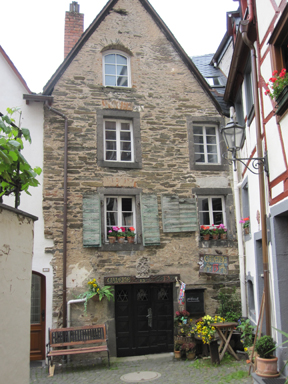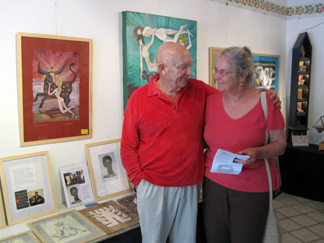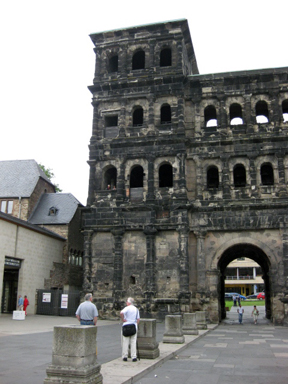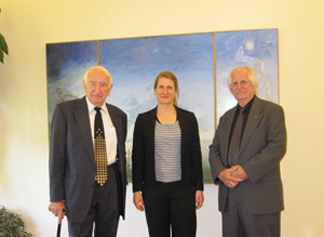Travel and Culture:
Cologne Revisited and Along The Mosel
By Cornelia Seckel
ART TIMES July/ August 2010
Cologne Revisited
I was in Cologne, Germany for the retrospective exhibition of Heinrich J. Jarczyk, an artist and friend for over 20 years, and we stayed with Christiane and Heinrich Jarczyk enjoying their gracious hospitality at their home just outside of Cologne. (See Raymond’s Exhibit Review in Jul/ Aug 2010 issue.) I have been to Germany many times and with this trip I was able to have a guide from the Cologne Tourism Bureau show me things that I have not seen before. Each time I am in Cologne, a city of 1 million people, I go to the Cathedral and am in awe of its size, grandeur and beauty. I was in Germany courtesy of Air Berlin, (www.airberlin.com) an airline that has reasonable prices, friendly flight attendants, and is generous with meals and drink. In my exploring of ticket fares theirs was the best price. They fly from New York, San Francisco, Los Angeles, Fort Myers, and Miami to hundreds of cities in Europe. It was quite convenient to get a flight directly from JFK to Düsseldorf. This May it was announced that Air Berlin, the second largest German airline, won the "World Airline Award" for the sixth time in succession. The award was given by Skytrax, a London-based consultancy company. Other contenders for first place in the category "Best Low-Cost Airline Europe" are Virgin America, EasyJet and JetBlue.
My guide, Ute Fendel, a PhD. in art history focusing on architecture, met me at the tourism office and we began our walk. I was particularly pleased as she looked at our website and read “about us” and some of the essays so that she would be more acquainted with ART TIMES and be able to tailor the tour. Over the years I have been to the Wallraf-Richartz-Museum, Museum Ludwig, Museum of Applied Art, Romano-Germanic Museum, Kolumba Art Museum (there are almost 40 museums and over 100 galleries) and to "ART COLOGNE", one of the oldest art fairs in the world and from which sprang Art Basel, Art Expo, etc. In autumn, Cologne plays host to "art.fair 21", a fair for current art with a young, trendsetting program. The "Cologne Fine Art & Antiques" fair also takes place in autumn, and mainly specializes in old and modern art as well as second-hand bookshops. I wanted to explore what was new in Cologne and so we went to the Rheinauhafen, the old dock quarter of Cologne from 100 years ago. Here historical buildings were converted into office buildings, apartment buildings (mostly condos but some as rentals) and studio space for artists. The old cranes from the dock area have become artists’ studios.
There are 3 “Crane houses” designed by architect Hadi Teheranim in the center of the area with additional new and renovated buildings coming to life on either side. Here there are also 3 galleries and several cafes. The promenade along the Rhine River has an international flavor and I felt as if I was in a vacation region, not the major city of Cologne. Below the promenade and just recently built is one of the longest parking garages in the world— nearly 1 mile of parking spaces! All of this came together through much planning and many investors. Tram and bus routes will continue to be extended from the city center. The Apple store is at the far end of the promenade (being an Apple fan, it is a good thing I didn’t know this till we had left the area!). Cologne was 95% destroyed during the war and so the people of Cologne are particularly invested in maintaining old monuments, keeping them intact and bringing new uses to them. This is something I have seen in many of the places I have travelled: Montréal and Québec City in Canada; Ventura, CA; Singapore, and surely in New York City and in the Hudson Valley, where I live.
Cologne is a city whose citizens have been supporting the arts for hundreds of years. There hasn’t been a ruling monarch for over 700 years, ever since the people of Cologne felt that the Archbishop of Cologne was too political and they ran him out. The reputation of the people in this city is of “free spirits” and understandably we see innovations in Music, Telecommunications, Electronics, Design and Art.
Art’otel is a chain of hotels that are in several cities throughout Europe. They are in cities where there is a vibrancy of local art, music and theatrical heritage. Each hotel is designed by an artist who is chosen by the parent company Park Plaza Hotels. A young Korean artist named only as SEO was appointed as the signature artist for art'otel in Cologne; Katharina Sieverding at art'otel Potsdam; A.R. Penck at art'otel Dresden; Donald Sultan at art'otel Budapest. For more information: www.artotels.com.
We left the promenade which I later learned was The Agrippina Dock, named for Agrippina who married Emperor Claudius. In 50 AD, she convinced him to acknowledge Oppidum Ubiorum and rename it Colonia Claudia Ara Agrippinensium. Today we know it as Cologne. So it is right that the Medieval tower along this dock houses the Women’s Media Tower that contains the Feminist Library and Archives whose founder was Alice Schwarzer, publisher of “Emma”, and the journalist who once campaigned alongside Simone de Beauvoir.
In the several last years we are seeing cooperation among cities and arts organizations for presenting the arts. The economic return has been well documented and here in Germany I learned that Cologne, Bonn and Düsseldorf (all Cities along the Rhine) will participate in Regionale 2010, a program to bring attention to the Rhine area (so much attention has gone to Berlin as the new Capitol of Germany).
After Ute headed back to the office to meet another tour I wandered back to the train station thru the Belgian Quarter — called so because of the street names. This area is the new “hot area” of Cologne (a younger “under 30” crowd) with many galleries, pubs, and clubs.
With all the new building in Cologne there is now a growing reputation for design and architecture. Some of the Highlights coming up in Cologne included: August 18-22 —Gamescom — Europe's largest trade fair for computer and video games takes place for the second time at the Cologne Exhibition; July 2-4 —Summer Jam Festival, the largest reggae, dancehall and world music festival in Europe, brings the Caribbean to Cologne on the banks of Lake Fühlinger;s September 21–26— photokina, the world’s leading trade fair for the “Imaging” industry –showcases the latest products, technologies and trends. Additionally, in March lit.COLOGNE, Europe's largest literature festival with events featuring famous artists and writers at befittingly extraordinary locations throughout Cologne; in April, Art Cologne, the most important art show in Germany and oldest such show, being a model for the many Art Fairs that have sprung up over the past 44 years. www.artcologne.de and in November, "Cologne Fine Art & Antiques" trade, an international art trade fair specialized increasingly in old and modern art, as well as antiques. www.cologne-fine-art.de
What a delightful and different look I had with special thanks to Air Berlin www.airberlin.de and Cologne Tourism www.koeln.de/cologne_tourist_information
Along The Mosel
We traveled with friends Jacky and Jörg who live in Berlin and often take us on excellent explorations in and around Germany (last year, we traveled along the Loire River in France).
While driving along the Mosel River (the longest tributary to the Rhine River) from Kobern-Gondorf to Trier, we saw miles and miles of vineyards (over 300 miles) as we explored wine restaurants, castles, and small villages, many from the Middle ages and older. The oldest settlement on the Mosel is Kues (also called Bernkastle-Kues), an early Stone Age (4000-3000 BC) village discovered in 1962. Then around 500 BC the Celts developed a culture in the Mosel region and left many traces including a strong indication of their wine growing. (The typical wine barrel that can be seen almost as a logo for wine and vineyards originated in the time of the Celts.) Then came the Romans in 56 BC when they invaded the country of Treveri (now Trier), followed by the Franks, a West Germanic tribal confederation, the French, and finally the Prussians. As we drove, many cyclists and hikers were making their way from town to town along the banks of the Mosel.
Our first stop was in Kobern-Gondorf to begin tasting the Riesling wines from the Riesling grapes that are growing along the Mosel — there are several other varieties as well. These nearly vertical vineyards are some of the steepest in the world. Cables hold workers from falling and carts carry the grapes, tools and workers to the small roads that go across the hills. It was a non-stopping view of these vineyards and every so often we would see someone tending the vines: pruning and tying them up. As we toured, we would stop at different restaurants to enjoy the wines of their vineyards, each a bit different, some more delicious than others.
We stayed in Cochem for 2 days and from there explored the towns on both sides of the Mosel. In Cochem we wandered along narrow streets, visited lots of shops and walked up to the Reichburg Castle (built about 1000 BC) that has been reconstructed and is open to visitors. We got there after they closed but were able to enjoy a glass of wine on the terrace. In Ediger -Eller we drove through the village on streets that barely were able to handle our small VW. Zell is a town on both sides of the Mosel and seems endless with restaurants, houses, great houses and, of course, the vineyards behind and above the town. Not far from Zell is the imposing ruin of the Stuben Monastery.
 The Synagogue in Beilstein, Germany. The Synagogue in Beilstein, Germany. |
We visited the town of Beilstein/ Mosel and after a tour of the Landshut Castle ruins I walked to the Jewish Cemetery, something I felt was a good obligation. Here we saw very old gravestones, most with dates we could not decipher. The newest headstone was for Lipmann (1998) a member of the Beilstein population and a group that early on hid Jews and provided papers and protection for the Jewish Community.
I wanted to see the Jewish Synagogue and so we rang the bell and just as we were giving up Karl Heinz Weibach answered the door. I told him that I was the publisher of an Arts Journal and understood that he was an artist. Not only is he an artist, but he owns the buildings that was once the synagogue for the Jewish population of Beilstein, and the surrounding villages, as well as the adjacent Rabbi’s house. In 1320 Beilstein was a refuge for the Jews of the Middle Ages as they were under the protection of the German Emperor Henry VII, who allowed 10 families to settle in Beilstein and build the Synagogue.
 Karl Heinz Weibach, caretaker of the Beilstein Synagogue and Cornelia Seckel in the sanctuary of the Beilstein Synagogue, Beilstein, Germany Karl Heinz Weibach, caretaker of the Beilstein Synagogue and Cornelia Seckel in the sanctuary of the Beilstein Synagogue, Beilstein, Germany |
Karl showed us his paintings and graciously gave us a tour of the synagogue showing us the area used for the Mikveh (ceremonial bathing area for women) and the gallery where the Torah would have been and where the men prayed. The women’s gallery was upstairs and is now being used for Karl’s studio. Today there are no artifacts left from the synagogue; in fact, in the years after there were no Jews in Beilstein (the time of the Nazi’s), the building was used as a barn that included a pig-sty, and animals were slaughtered in what had been the Mikveh. I felt very moved as Karl told us his story. Karl has lived in the US for many years, raising his family in California and also living in San Miguel Allende in Mexico. Karl’s family is from Beilstein (perhaps they were the last of the Jews living in Beilstein) and he is understandably reluctant to speak of those times although he did show us a picture of his father after he was released from a concentration camp. Karl returns to Beilstein each year to maintain the Synagogue with the hope that a Jewish Organization will take up the mantel and bring to light to the world the contributions of the Jewish people to the region (they have been in the Mosel region since the time of the Romans) and the history of a people that at one time comprised 1/3 of the population of Beilstein and, before the time of the Nazis, nearly 25%. If you know of an organization that might help let me know at cs@arttimesjournal.com.
On our 3rd day we headed to Bernkastel-Kues and the most perfect hotel — the 3 Kings Hotel (Hotel Drei König) www.hoteldreikoenige.de overlooking the Mosel with a view of the Landshut Castle. Our host, Uwe Linke, is continuing to run his family’s hotel built in 1901. He is also a very accomplished painter and throughout the Hotel are his bold colored oils of places he has traveled to over the years. It is on the order of the Grand Hotel in Brighton, England. In the evening Jacky & Jörg would join us on the balcony from our room and we would watch the town come alive with lights, the Castle become illuminated, and the barges and pleasure boats continue their travels along the Mosel. There were many boats that carried passengers along a tour of the Rhine and Mosel and some boats were available for day trips. I felt as if I was in a fairy-land. As we explored towns around Bernkastel-Kues we stopped at an old Roman Winery and was able to see some of the ruins and a reconstruction of the herb gardens, that as I understood, the Romans used often in their wine.
 Porta Nigra (to the left is the Stadtmuseum), Trier, Germany Porta Nigra (to the left is the Stadtmuseum), Trier, Germany |
On Day 4 we explored Trier, the site of the Roman invasion, which resulted in the destruction of the Celt culture and the founding of the first town and in fact an imperial Roman residence and the largest town North of the Alps. We walked our feet off from the Porta Nigra, a Roman monument built without mortar or purpose other than as a demonstration of power and then in subsequent years used as a Church, and then to the ruins of the Roman Baths. Next to Porta Nigra is the Stadtmuseum where Raymond saw the Max Lazarus exhibition, “The Jewish Fate of an Artist” (see ART TIMES July/ Aug 2010 issue.) As we wandered through the suggested “tourist Route” we saw a late Romanesque Residential Tower from the 13th Century, the main marketplace which had an abundance of fruits and vegetables, and then on to the Church of our Lady (Liebfrauenkirche), the oldest Gothic church in Germany, the Cathedral St. Peter, the oldest bishop’s church in Germany with the Roman central section from the 4th century, and then on to the Roman Basilika, the throne room of Emperor Constantine the Great – 4th century, and the ruins of the 4th Century Imperial Baths with extensive subterranean passageways. A story I heard while visiting the Cathedral was that Constantine, the first Christian emperor, convinced his mother (St Helene) to donate their family villa to the church and what resulted is this oldest church in Germany that houses artworks and a holy relic, the Holy Robe of Christ.
Our last day of the tour we had a leisurely breakfast at our fine hotel, perhaps my favorite hotel of all times, and then headed back towards Cologne. On our way we stopped at Eltz Castle. This is the kind of castle I like to tour. Owned by the same family for the past 33 generations (nearly 1000 years), and never destroyed by war. The artifacts in the castle: beds, armors, heating stoves, clocks, water closets, kitchen utensils, pots, armor and weapons were part of the castle and belonged to the family, and not brought in as reconstructions. In the Great Hall were photographs of the current Count, Count Karl, and his family. Flowers brought to the castle by the Countess each week from her gardens in Frankfurt (they don’t live at the Castle although there is electricity and running water) adorn each of the rooms we viewed: living room, master bedroom, The Electors’ room (a place where the Count conducted his business), children’s room, hunting room, Armory, Banner Hall (most likely a chapel), the Countesses bedroom, a workroom, and the kitchen with eating area. As no one wrote during most of the years of occupancy there are no detailed records from the family.
So that was our tour of the Mosel Region and what a fine time we had.
 (L to R) Heinrich J. Jarczyk, Alexandra Marquetant(curator) and Raymond J. Steiner at the exhibition of Jarczyk's work at Haus Schlesian, Königswinter, Germany (L to R) Heinrich J. Jarczyk, Alexandra Marquetant(curator) and Raymond J. Steiner at the exhibition of Jarczyk's work at Haus Schlesian, Königswinter, Germany |
Back to Cologne and then Königswinter for the exhibition of work by Heinrich J. Jarczyk www.jarczyk.de at the Haus Schlesian. What a pleasure to see these watercolors and drawings from his travels. In Germany, the exhibition openings have a program. A musical interlude, then introductions, and then speeches by the curator, the head of the Haus Schlesian, Heinrich and then heartwarming words from Raymond of his long association and praise for Heinrich — the man and his work. The formalities ended with a harp recital by Heinrich’s daughter Konstanze Jarczyk and then wine was served and we all enjoyed the artwork.
What a joy to combine our work with the pleasure of seeing friends, fine artwork, interesting places, beautiful gardens, fine wines and good food.
